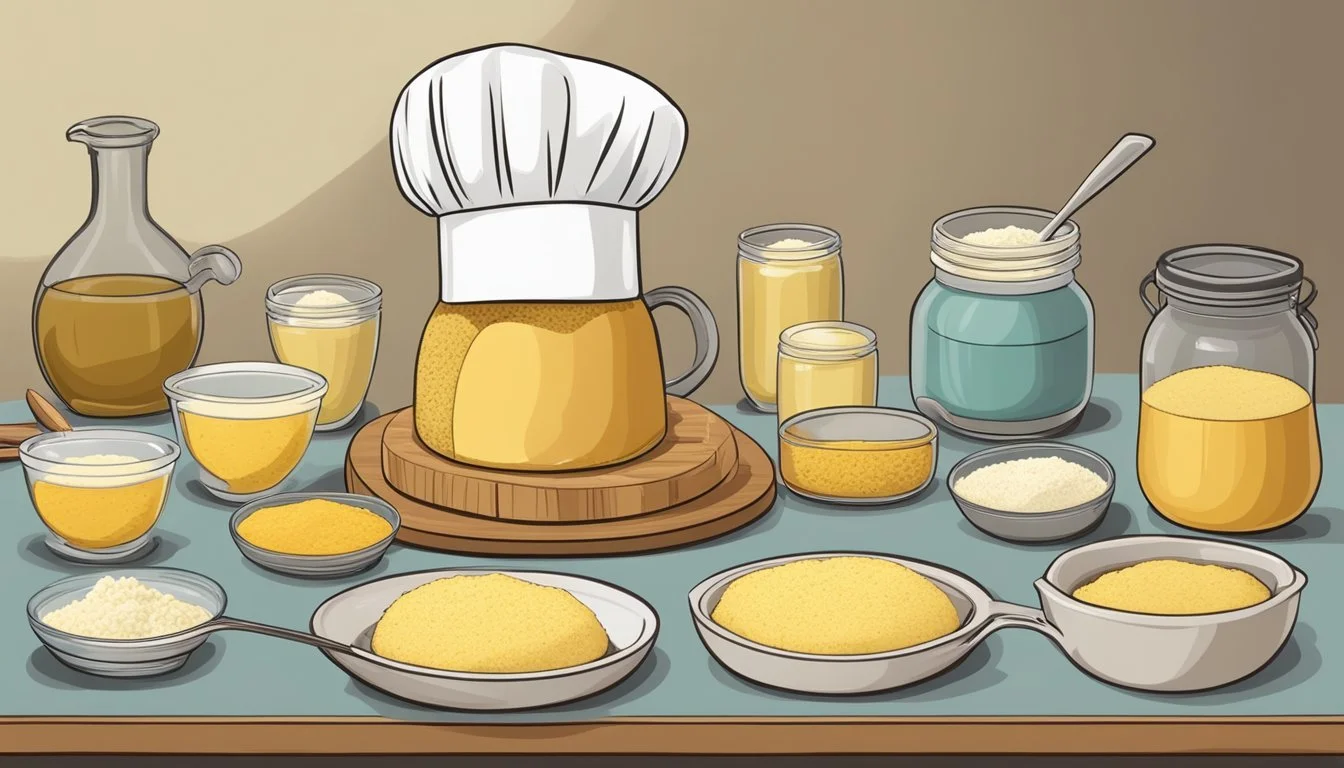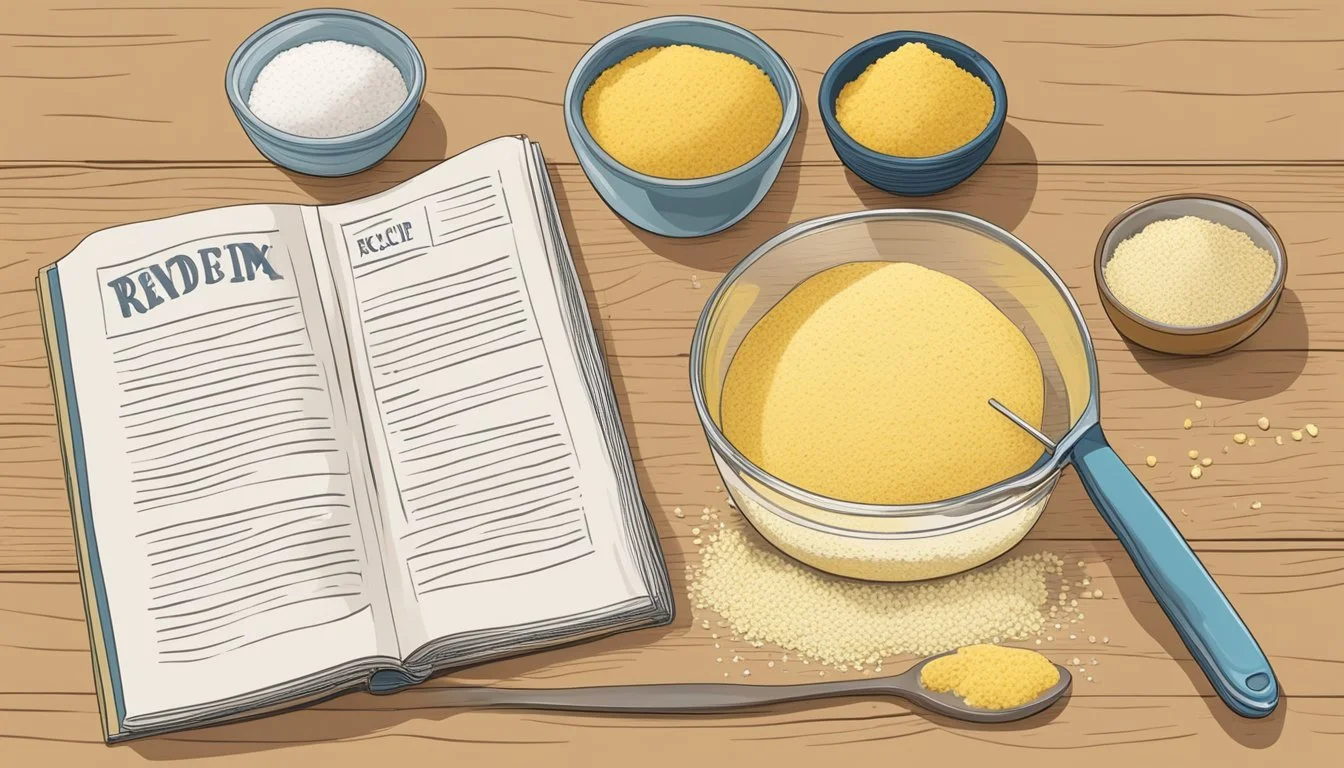Cornbread Substitutes
Top Alternatives for Your Favorite Sides
Cornbread, a classic comfort food that's rich with tradition, often serves as a staple at many family dinners and gatherings. While the traditional recipe relies heavily on cornmeal and eggs, dietary preferences and restrictions have led many to seek out alternatives. These substitutes not only cater to vegan and allergy-friendly diets but can also offer a twist on the classic flavor and texture.
Egg substitutes in cornbread have gained popularity as they allow for greater dietary inclusivity without compromising on taste or texture. Options such as vegan mayonnaise, sour cream, applesauce, and silken tofu provide different benefits: from adding moisture to boosting protein content. Each substitute carries its own unique qualities, ensuring that the resulting cornbread maintains its signature crumb and taste profile.
Exploring alternatives to cornmeal is another aspect of modifying cornbread recipes. Uncommon in traditional recipes, options like almond flour have begun to rise in interest. This particular alternative not only modifies the flavor but also the nutritional content, making it a suitable option for those adhering to gluten-free diets. With thoughtful consideration of ingredients, cornbread can be adapted to meet a variety of dietary needs while still preserving its soul-food essence.
Understanding Cornbread
In exploring cornbread, it's vital to consider the ingredients and their functions, as well as the various types of cornbread that exist.
Ingredients and Their Roles
The classic cornbread recipe calls for cornmeal, which provides the distinctive texture and slightly sweet flavor of the bread. Cornmeal, usually made from ground dried corn, is the cornerstone ingredient of cornbread. It often combines with flour to create a balanced structure, where the flour's gluten content helps to bind the mixture for a stable crumb.
Common leavening agents, such as baking powder, are integral for achieving the right rise in cornbread. When activated, it releases carbon dioxide creating pockets of air that allow the bread to rise and become fluffy.
The wet ingredients usually include eggs and milk. Eggs contribute to the overall structure and stability, adding richness to the flavor, while milk introduces moisture and enhances the tender texture of the bread.
Cornbread Varieties
Different regions boast unique takes on this staple dish. Southern-style cornbread is traditionally made with mostly cornmeal and little to no sugar, resulting in a savory, crumbly bread. Northern-style cornbread often includes a higher proportion of flour and sugar, creating a cake-like, sweetened version.
Basic Cornbread Substitutes
When traditional ingredients are unavailable, several substitutes can be utilized to create a satisfying cornbread. These alternatives mainly revolve around flour replacements and leavening adjustments.
Flour Alternatives
One can replace cornmeal with a variety of flour options to maintain texture and flavor. Wheat flour can be used for its texture, although it will not mimic the flavor of corn. Rice flour is a gluten-free alternative that offers a fine texture, suitable for those with dietary restrictions.
Substitutes for Cornmeal:
Corn flour: Similar in flavor, finer in texture.
Wheat flour: Commonly available, but lacks the distinct corn taste.
Rice flour: Offers a fine texture, good for gluten-free requirements.
Leavening Agents
For cornbread to rise properly without traditional leavening agents, one can use baking soda and vinegar as a chemical leavening substitute. This combination creates a reaction that releases carbon dioxide, contributing to the bread's rise.
Substitute for Baking Powder:
Baking soda (1/4 tsp) + vinegar (1 tsp): Combine and use for every teaspoon of baking powder required.
Substitutes for Dietary Restrictions
Finding suitable substitutes for common allergens and dietary restrictions can maintain the joy of enjoying cornbread for everyone. The following subsections offer specific alternatives for eggs, dairy, and gluten, catering to various dietary needs.
Egg Substitutes
For those avoiding eggs due to allergies or vegan preferences, several reliable alternatives can provide similar binding properties in cornbread recipes:
Flaxseed or Chia Seeds: Mix 1 tablespoon of ground flaxseed or chia seeds with 3 tablespoons of water to replace one egg. Allow it to rest until it forms a gel-like consistency.
Applesauce: Use 1/4 cup of unsweetened applesauce to substitute one egg, which also adds moisture to the cornbread.
Vegan Mayo: In place of each egg, 3 tablespoons of vegan mayonnaise can be used, adding richness without using animal products.
Dairy-Free Options
Dairy products are commonly used in cornbread, but those with lactose intolerance or following a dairy-free diet have alternatives such as:
Soy, Almond, or Coconut Milk: These can be used in a 1:1 ratio in place of cow's milk.
Vegan Butter: Substitute dairy butter with the same amount of vegan butter or a neutral oil like canola.
Dairy-Free Yogurt or Buttermilk: If the recipe calls for buttermilk, one can mix dairy-free milk with a tablespoon of vinegar or lemon juice to replicate the tanginess.
Gluten-Free Ingredients
To accommodate those with gluten sensitivity or celiac disease, gluten-free options are essential:
Chickpea Flour: It’s a nutritious gluten-free substitute that provides a slightly denser texture.
Almond Flour: When combined with other gluten-free flours, almond flour can impart a rich, nutty flavor.
Certified Gluten-Free Oats: Ground into a flour, they can replace cornmeal fully or partially, though one should ensure they are certified gluten-free to avoid cross-contamination.
Substitutes to Enhance Flavor and Texture
Cornbread can be transformed with various substitutes that not only maintain its structural integrity but also enrich its flavor and texture. Selecting the right ingredient can elevate the taste profile from sweet to savory and alter the crumb from moist to hearty.
Sweet and Savory Enhancers
Sweet Flavor: For a sweeter cornbread, applesauce can be used. Applesauce acts as a natural sweetener and also contributes to a moist texture. To replace one egg, use 1/4 cup of applesauce.
Savory Taste: Greek yogurt or sour cream can be used to add a tangy flavor, enhancing the cornbread's savory notes. They also improve the moistness, complementing the cornmeal's natural flavor. A one-to-one substitution can be used for milk or as an egg alternative.
Texture Modifiers
Thicken: To achieve a denser cornbread, mashed banana serves as an effective thickening agent. This also imparts a subtle banana flavor, adding to the overall complexity of taste. Use 1/4 cup of mashed banana per egg.
Moisture and Binding: For added moisture without altering the taste significantly, plain yogurt can be used. As a binder, yogurt maintains the bread's cohesion and gives a soft texture. It can replace eggs in the same amount as the recipe calls for.
Novel Cornbread Recipes
Exploring novel cornbread recipes involves a fresh take on classic techniques and infusing flavors from various culinary traditions. These innovations provide a delightful twist to the traditional cornbread experience.
Innovative Ingredient Combinations
In the quest for unique cornbread recipes, one can swap out traditional cornmeal with blended sweet corn. By mixing pureed corn with whole milk, unsalted butter, eggs, and sour cream, a rich base that mimics the texture of cornmeal is created, offering a fresh approach to the cornbread texture and taste.
Flaxseeds ground into a meal offer a nutritious alternative to eggs, making the recipe suitable for vegans. These seeds are not only a source of omega-3 fatty acids, protein, and fiber, but also act as a binding agent in the cornbread.
Ingredients Substitutes Notes Cornmeal Blended corn, milk, and sour cream Offers a fresh texture and sweetness. Eggs Ground flax seeds Provides a vegan option while adding nutritional value.
Global Inspirations
Cornbread's adaptability can be showcased by drawing inspiration from different corners of the globe. Ingredients like polenta, an Italian corn-based staple, can enrich the authenticity and texture of the cornbread. Incorporating polenta in the recipe imparts a distinct, rustic flavor and a hearty consistency.
Johnnycakes and hushpuppies demonstrate the versatility of corn-based dishes across cuisines. By borrowing spices used in these recipes, such as cayenne pepper or scallions, chefs can introduce an array of flavors to elevate the humble cornbread. Similarly, modifying the cooking method, such as frying instead of baking, can offer a nod to hushpuppies in creating a crustier exterior.
Johnnycakes inspired cornbread could be made thinner, with a crisper crust, replicating the griddled effect.
Hushpuppies fusion might involve adding minced onions, jalapeños, and a touch of sugar to the batter, then deep-frying small dollops to achieve a golden brown finish.
By integrating these international influences, cornbread takes on a new life that transcends geographic boundaries and invites a global palate.
Healthier Alternatives for Cornbread
When seeking to make cornbread healthier, one can focus on reducing the dish’s calorie count while boosting its nutritional profile. This can be achieved through incorporating ingredients that are lower in calories but high in beneficial nutrients such as protein and omega-3 fatty acids.
Reducing Caloric Intake
To lower the calorie content of cornbread, ingredients like Greek yogurt can be used to replace higher-calorie alternatives such as oil or butter. Greek yogurt not only reduces the total fat content but also contributes to a moist texture. One effective swap is using applesauce or mashed bananas in place of a portion of the sugar or fats, which also adds natural sweetness and fiber.
Example Substitute: Use 1 cup of Greek yogurt to replace an equal amount of oil or butter.
Additional Tip: Swap out sugar for pureed fruits like applesauce or bananas to maintain sweetness with fewer calories.
Increasing Nutritional Value
Enhancing the nutritional value of cornbread involves incorporating ingredients rich in protein, fiber, and omega-3 fatty acids. Flaxseeds or chia seeds are excellent choices for such an upgrade. They are dense in nutrients and serve as great egg substitutes due to their binding properties when mixed with water.
Flaxseed: Mix 1 tablespoon of ground flaxseeds with 3 tablespoons of water to replace one egg in cornbread recipes.
Chia Seeds: Use 1 tablespoon of chia seeds with 3 tablespoons of water, let sit for 5 minutes, then use as an egg substitute.
Boosting Protein: Including almond flour as part of your flour mix will not only add protein but also impart a slightly nutty flavor to the cornbread.
These substitutions help create a cornbread that is both satisfying and more aligned with health-conscious dietary choices.
Troubleshooting Cornbread Substitutions
Making substitutions in cornbread recipes can be straightforward, but occasionally adjustments are necessary to achieve the desired texture and flavor. This section addresses common issues and offers specific solutions, especially when it comes to achieving the right consistency.
Common Issues and Fixes
1. Substitute Thickness: When substituting liquid ingredients, the batter may become too runny. In such cases, a thickening agent like cornstarch or arrowroot powder may be needed. A teaspoon at a time can help achieve the correct batter thickness.
2. Flavor Alteration: Pureed fruits or mayo can replace fats and sugars, offering a healthier alternative. However, they might change the flavor profile slightly. Taste the batter and adjust spices accordingly.
3. Binding Problems: Eggs are crucial for binding. When replaced with flax seeds or aquafaba, bakers sometimes experience a crumbly texture. To avoid this, ensure that the substitutes are well prepared. For example, flax seeds should be finely ground and mixed with water to form a gelatinous consistency before adding to the mix.
Adjusting Recipes for Consistency
Consistency with Flour Substitutes:
Semolina or polenta flour can serve as substitutes for cornmeal to vary texture but may require more liquids. Monitor the batter and add milk or water sparingly to not thin it out excessively.
Liquid Ingredients:
When using substitutes that are wetter than the original ingredient (like honey for sugar), the overall liquid content increases. To balance this out, reduce other liquid ingredients or add dry ingredients incrementally.
Baking Adjustments:
Oven temperatures and baking times may need slight alterations. Ingredients like pureed fruits can add moisture, potentially requiring a longer baking time. Check the cornbread with a toothpick inserted into the center; it should come out clean when done.
Conclusion
Exploring alternatives to traditional cornbread ingredients can lead to nutritious and delightful variations of this classic dish. One can confidently replace eggs with a variety of plant-based options while maintaining the desired texture and flavor profiles. Flax seeds and applesauce offer rich nutrients and moisture, while silken tofu provides a binder with additional protein content. In cases of dairy restrictions or preferences, Greek yogurt can be an effective replacement for eggs, both enhancing the texture and introducing beneficial probiotics.
Table: Cornbread Egg Substitutes
Substitute Measurement per Egg Beneficial Nutrients Flax Seeds 1 tbsp ground flax mixed with 2.5 tbsp water Omega-3 acids, fiber, protein Applesauce 1/4 cup Fiber Silken Tofu 1/4 cup pureed Protein, calcium Greek Yogurt 1/4 cup Protein, probiotics Aquafaba 3 tbsp None (though cholesterol-free)
One should also consider the versatility of aquafaba, the liquid from canned chickpeas, which acts as a unique vegan substitute that is suitable for those avoiding animal products. Each substitute brings unique qualities to the table, allowing individuals to tailor their cornbread to specific dietary needs and preferences.
In conclusion, these various substitutions create opportunities for individuals to enjoy cornbread in a way that aligns with their dietary choices without compromising the dish’s integrity.






